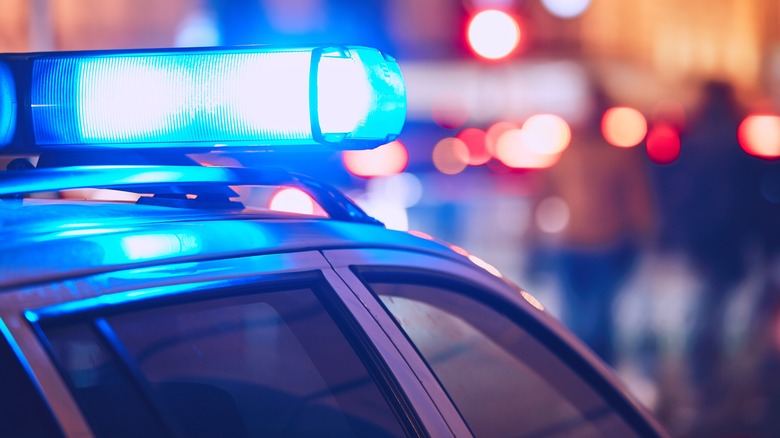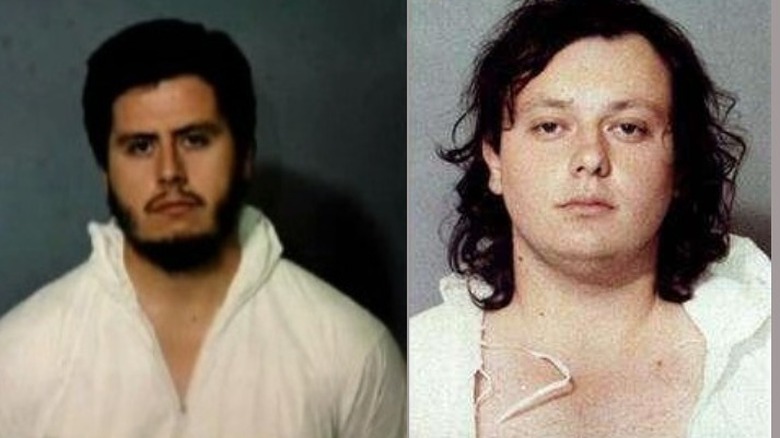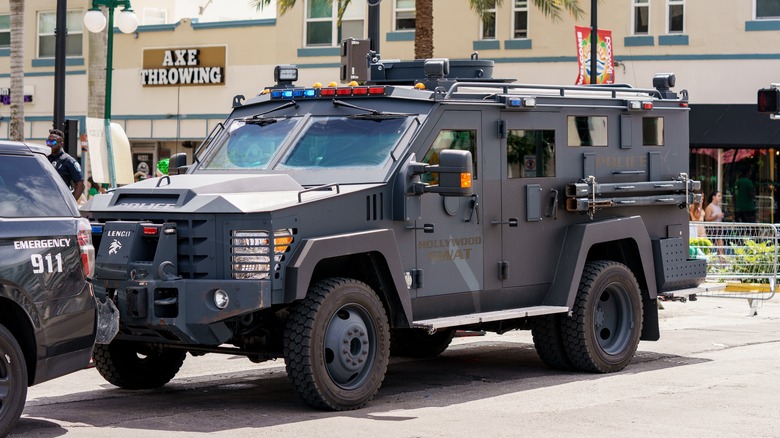How The North Hollywood Shootout Led To The Now-Controversial 1033 Program
On the morning of February 28, 1997, two men wearing body armor and with an arsenal of weapons exited the North Hollywood branch of the Bank of America they'd just robbed, per Newsweek. When members of the Los Angeles Police Department attempted to confront the bank robbers as they left the bank, one of the fiercest gun battles in U.S. law-enforcement history began, according to Police Magazine.
The ensuing shootout lasted 44 minutes and left 12 police officers and eight civilians wounded, as the two bank robbers' armor-piercing bullets from their Kalashnikov-style assault rifles tore through concrete, cars, a news helicopter, flesh and bone, and police officer's bullet-proof vests, per CNN. The two criminals, Larry Phillips Jr., and Emil Mătăsăreanu, went through 2,000 rounds as they attempted to escape with $300,000 in cash, according to the Crime Museum, and it all unfolded on live television, per Newsweek. While all these elements make this gun battle memorable, the event's true importance lies in how it changed policing in America.
Who were the North Hollywood Bank Robbers?
Emil Mătăsăreanu, 30, and 26-year-old Larry Phillips Jr., spent months planning the bank heist after becoming friends at a local gym, per the Crime Museum. Before the Bank of America robbery, the pair had already been involved in other heists, per Los Angeles Magazine. On the morning of the robbery, the two men entered the bank just after 9 a.m., wearing ski masks and body armor, shot their way through the vault, and headed for the exit, according to Newsweek. Outside, LAPD officers told the men to drop their weapons, but the robbers opened fire on the police, who were completely outgunned, per CNN.
Before SWAT teams arrived, the responding police only had service pistols, either 9 mm handguns or .38 revolvers, and shotguns, which couldn't penetrate Phillips and Mătăsăreanu's body armor, according to CNN. The two robbers' weapons were illegally modified for fully automatic gunfire, meaning they could simply hold down the triggers and the bullets would keep pouring out, per Police Magazine. Their armor-piercing rounds went through the officer' vests "like a hot knife through butter," Rick Massa, who was an LAPD SWAT member involved in the gun battle, recounted to CNN in 2017. The two bank robbers eventually died during the shootout. Phillips, after being shot in the hand and surrounded, committed suicide, according to the Crime Museum. Mătăsăreanu, after trying to flee in a getaway car, died from blood loss after being shot in the legs, per Los Angeles Magazine.
The Controversial Federal Program that Militarized the Police
In the aftermath of the North Hollywood Shootout, the controversial 1033 program, included in the National Defense Authorization Act of 1997, allowed the Department of Defense to provide surplus military equipment to requesting police agencies, according to the 2020 book "Criminal Justice in America: The Encyclopedia of Crime, Law Enforcement, Courts, and Corrections." Within seven months, the LAPD had 700 M-16s at their disposal, per the book. The program has militarized police departments across the country by providing them with everything from grenade launchers to armored vehicles, according to Wired Magazine. More than 8,000 federal, state, and local law enforcement agencies have taken part in the program that has given them $7.6 billion worth of equipment, per the Defense Logistics Agency, which oversees the distribution.
While proponents of the 1033 program claim it has made America's streets safer, detractors, argue it has done the opposite. "Our research suggests that officers with military hardware and mindsets will resort to violence more quickly and often," Ryan Welch, a University of Tampa political scientist told Wired in a 2020 interview. For better or worse, the 1997 North Hollywood shootout helped change the nature of policing in the U.S.


